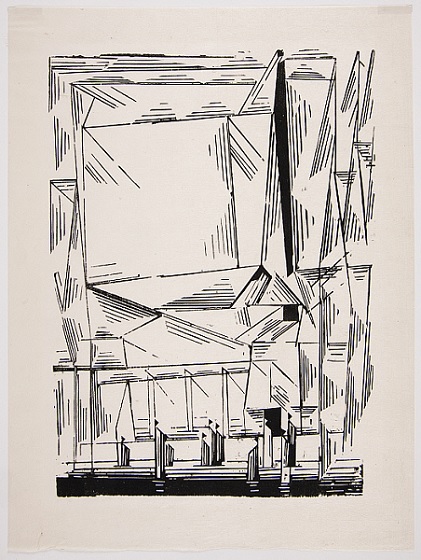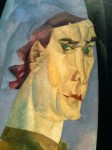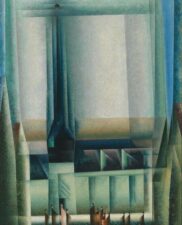
Lyonel Feininger
American, 1871-1956 (active Germany)
Gelmeroda, 1920
woodcut on paper
13 1/8 x 9 3/4 in.
SBMA, Anonymous Gift
1966.73

Lyonel Feininger, Self Portrait, 1915, oil on canvas
"My aim is a passionate longing for rigorous spatial design..without painterly intoxication of any sort." - Lyonel Feininger

Lyonel Feininger – Gelmeroda VIII, 1921
COMMENTS
Though originally from New York, Lyonel Feininger spent a great deal of his career in Germany and is closely associated with the German Expressionist movement as well as the Bauhaus, where he was an active teacher and practitioner. Early Cubism and Futurism acted as significant sources of inspiration in the development of Feininger’s personal style, characterized by angular lines and transparent intersecting planes. When the Bauhaus was dissolved by the Nazi party in the late 1930s, Feininger returned to his native New York, adding a series of skylines and seascapes to his already prolific body of work.
https://www.artsy.net/artwork/lyonel-feininger-gelmeroda-5
Gelmeroda is a small village on the outskirts of Weimar that Lyonel Feininger first visited in the summer of 1906. Soon thereafter, the town and its Gothic church began to appear as a backdrop in his figurative oils and drawings. In 1913, he painted the first of what would be a series of thirteen monumental oils focusing exclusively on the church and its spire. Executed over the course of more than two decades, the Gelmeroda series charts Feininger's changing treatment of light and form. Gelmeroda, VIII, painted during Feininger’s tenure as a professor at the Bauhaus in Weimar, demonstrates the artist’s engagement with a vocabulary of layered, prismatic forms during this period. Set into the surrounding sky like a faceted jewel, the church seems to embody Feininger’s assertion that he was interested in painting the space around objects, not objects themselves. The solemn churchgoers at the lower edge—figures who establish the monumental scale of the architecture—seem similarly incorporeal, reduced to a group of translucent, earthbound triangles. The effect, however, is not one of traditional hierarchy, but of unity: in Feininger’s painting, heaven and earth are facets of a single, ethereal reality.
https://whitney.org/collection/works/386
Gelmeroda from the Masters' Portfolio of the Staatliches Bauhaus (Meistermappe des Staatlichen Bauhauses) (1920, published 1923)
The range of approaches in this portfolio evidences the lack of a single Bauhaus style. All of the contributors were "masters," or artist-teachers, at the school. Vasily Kandinsky, László Moholy-Nagy, and Lothar Schreyer created abstract compositions. Paul Klee offered a whimsical erotic scene, while Gerhard Marcks provided a sentimental representation of a mother and child. Lyonel Feininger's and Georg Muche's works are formal experiments showing Cubist influences. What all these prints had in common was the artists' belief in the mission of the Bauhaus and its goal of reshaping modern life through art and design. The sales of the portfolio benefited the school, which was in dire need of funds during the period of runaway inflation in the early years of the Weimar Republic.
PUBLISHING HISTORY
As head of the Bauhaus printing workshop, Feininger directed the monumental project. In addition to designing the portfolio cover and lettering, he oversaw the hand-printing of the entire edition, a process that consisted of rendering more than eight hundred compositions of varying levels of technical complexity onto a range of papers. This painstaking production reflects Feininger's emphasis on the artistic, rather than the reproductive, aspect of printmaking as well as the Bauhaus's craft orientation in its early years.
https://www.moma.org/collection/works/62414
